|
|
|
CONRAD HERWIG
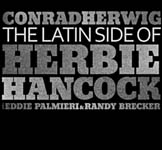 The
Latin Side of Herbie Hancock The
Latin Side of Herbie Hancock
Half
Note Records
By Tom
Ineck
Trombonist
Conrad Herwig has been successfully “Latinizing” legendary jazz
composers at least since 1996, with his homage to John Coltrane, and
continuing with similar treatments of Miles Davis and Wayne Shorter
tunes. Now Herwig has convened a who’s who of great players to interpret
the music of Herbie Hancock with a distinct Afro-Cuban tinge. Recorded
at the Blue Note club in New York City during a two-day stint in August
2008, “The Latin Side of Herbie Hancock” seethes with instrumental fire
and infectious rhythms.
The
essential nucleus of this explosive ensemble is, of course, the rhythm
section, which consists of Pianist Bill O’Connell, bassist Ruben
Rodriguez, drummer Robby Ameen and percussionist Pedro Martinez. They
provide the fundamental backdrop for Herwig’s powerful trombone
excursions and the equally formidable playing of Craig Handy (on tenor
and soprano saxophones, flute and bass clarinet), trumpeter Mike
Rodriguez and special guests Eddie Palmieri on piano and Randy Brecker
on trumpet. The result is magical.
Things
start off with a bang on a 10-minute rendition of Hancock’s exotic
“Oliloqui Valley.” Brecker takes the first solo, dramatically building
the intensity with multi-note flourishes and high notes, followed by
Handy on tenor, Herwig on trombone and Palmieri, who takes the tune to
the next level with pounding chord clusters. The crowning glory,
however, is the harmonized three-horn interlude that follows—a passage
by Herwig, Handy and Brecker that quotes a Hancock piano solo verbatim.
The tempo increases for an intricate O’Connell arrangement of “One
Finger Snap,” with Rodriguez in the trumpet seat. Herwig takes a lengthy
solo with confidence and imagination, and Ameen on drums and Martinez on
congas combine for a wailing percussion duet.
The mood is
considerably more relaxed on “Butterfly,” a Herwig arrangement that
allows for plenty of breathing space. Handy is featured on a bass
clarinet solo of great beauty and warmth, but trumpeter Rodriquez,
Herwig and O’Connell also make sensitive solo statements. “The Sorcerer”
is a potently pulsating vehicle for solos by O’Connell, Brecker and
Herwig, capped by a set of incendiary trades between trumpet and
trombone. The funk factor is palpable on “Actual Proof,” which lends
another opportunity for Brecker to soar through the changes.
This
stellar performance ends with three timeless Hancock tunes. “Maiden
Voyage” is a gently flowing O’Connell arrangement featuring Handy on a
light and lilting flute. Brecker and Palmieri return for “Cantaloupe
Island,” and a tour-de-force “Watermelon Man.” Even though he appears on
only three of the eight tracks, the venerable Palmieri deserves special
credit for infusing this recording with an authentic Latin groove.
Drawing on
a broad range of Hancock tunes, from his early 1960s classics to his
1974 funk-fusion favorite, “Thrust,” Herwig’s homage reminds the
listener how influential and adaptable the pianist-composer has been
over the years. And isn’t that what makes such tributes so valuable?
top |
|
|
|
JOHN SCOFIELD
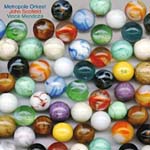 54 54
EmArcy
Records
By Tom
Ineck
As if to
emphasize strength in numbers, the title of John Scofield’s latest
release focuses like a laser on the 54-piece Metropole Orchestra that
helps to raise the guitarist’s own latent funk and fusion potency to
new, more majestic heights. It is an astonishing collaboration further
aided and abetted by the imaginative arrangements and conducting of
Vince Mendoza.
It is a
distinct departure from last year’s soulful “Piety Street,” a New
Orleans gospel celebration on which Scofield fronts a stripped-down
combo also featuring organ, bass, drums, and lots of vocals. Here, the
orchestral horns, strings and percussion create a lush and colorful
palette over which Scofield can spin his snaking, fluid guitar lines.
But the arrangements deftly allow the ensemble to help build the
intensity and interact with the guitarist in a powerful and exhilarating
call-and-response. The orchestra also showcases some of its excellent
soloists.
“Carlos”
opens the proceedings with the orchestra stating the theme and Scofield
eventually entering the fray only tentatively. After restating the
melody briefly on guitar, he turns it over to the band, which ups the
ante. Well into this nearly nine-minute piece, Scofield leaps into a
stirring solo with his trademark octaves and fleet single-note runs.
Saxophonist Paul van der Feen takes a solo before returning it over to
his colleagues, who then pass it to Scofield for a final funky
statement.
The
mid-tempo swinger “Jung Parade” is one of two compositions by Mendoza.
Complex string and brass harmonies and thundering tympanis threaten to
obscure the soloists, but Scofield and trumpeter Ruud Breuls break
through for some inspired playing. There is no mistaking the guitarist’s
presence on his funky rock tune “Polo Towers.” He lets the crunchy
signature chords sustain for full effect, and then bites into nasty
single-note runs and occasional octaves. This time it’s Marc Scholten on
alto sax that gets the backup solo.
Scofield’s
gorgeous ballad “Honest I Do” reminds the listener just how powerful a
well-arranged and conducted orchestra can sound with the right material.
The guitarist puts the essential grace notes on a big production. The
Crescent City beat of “Twang” again has Scofield in funk territory, with
trombonist Bart van Lier helping out with a bluesy tailgating solo.
“Imaginary Time” does, indeed, suspend from an implied tempo with the
orchestral instruments hovering around it and Scofield winding deep
inside as he explores the harmonic variations. Tenor saxophonist Leo
Janssen and drummer Martijn Vink help define the tune and its rhythmic
core.
Scofield
turns on the funk and wah-wah effects on the infectious “Peculiar,”
building to a squalling crescendo. Hans Vroomans helps to build the
tension even higher with a Hammond organ solo, before he, Scofield and
the whole orchestra trade licks to the finish. The mood suddenly turns
romantic on Mendoza’s “Say We Did” with Vroomans at the piano and
Janssen on tenor sax joining with Scofield to create a work of art. The
lush orchestral palette is especially effective here, alternating from
dark brass to light strings. The swinging, robust tune “Out of the City”
makes for an optimistic closer and allows the guitarist to soar on the
fret board one more time.
Most of the
nine tunes—seven by Scofield—run between seven and nine minutes,
allowing for plenty of instrumental interplay and the gradual building
of themes. The ambitious project presents the guitarist in a setting
worthy of his immense talent.
top |
|
|
|
KEITH JARRETT / CHARLIE HADEN
 Jasmine Jasmine
ECM
Records
By Tom
Ineck
Both
pianist Keith Jarrett and bassist Charlie Haden have a deep appreciation
for the standard repertoire and the importance of intimacy in playing
and recording. Jarrett has dozens of solo releases, most of them made
live in concert, and his favored setting over the last 25 years has been
in the “standards” trio also featuring bassist Gary Peacock and drummer
Jack DeJohnette. Throughout his career Haden has explored a variety of
musical conversation, often in a duo format with pianists—Hank Jones,
Kenny Barron, Chris Anderson, Gonzalo Rubalcaba and, now, Jarrett.
The two
masters are near contemporaries (Jarrett is 65 and Haden is 73) and old
friends, and that’s exactly what “Jasmine” sounds like. They hadn’t
played together in more than 30 years, but the compatibility is evident
from the first tune, the sentimental classic “For All We Know.” A
quality of clarity and artful meditation pervades the performances, as
though both men understand the historical nature of this collaboration.
They listen to one another and respond, never rushing the tempo, never
hogging the limelight, always aware of the power of judicious pauses and
silence.
“Where Can
I Go Without You,” a love song made popular by Peggy Lee, Nat Cole, and
Nina Simone, among others, is evidence of the great lyrical quality
inherent in the playing of Jarrett and Haden. Their phrasing “breathes,”
just as a tasteful singer would deliver the lyrics, “I went to London
Town, to clear up my mind. Then on to Paris, for the fun I couldn’t
find. I found I couldn’t leave my memories behind. Where can I go
without you?” The two develop this theme for nearly nine and a half
minutes, and it’s not a second too long.
The tempo
increases for the mysterious “No Moon at All,” allowing Jarrett to range
deftly over the keyboard as he sets up Haden for a counterpoint solo.
The next tune is not usually considered a standard. Penned by Joe Sample
of the Jazz Crusaders, “One Day I’ll Fly Away” works beautifully here,
again inspiring romantic passages from both Jarrett and Haden. Though
the Will Jennings lyrics are not sung here, the lyrics are
instructional: “One day I’ll fly away, leave all this to yesterday. Why
live life from dream to dream, and dread the day when dreaming ends?”
The longest
piece goes over 12 minutes. Jarrett eases us into it with a brief
introduction, and then the duo immerses itself in the depths of “I’m
Gonna Laugh You Right Out of My Life,” taken at an appropriately sad and
wistful tempo. Jarrett seems especially inspired in a solo of exquisite
beauty (and a few trademark vocal moans). Haden follows with a typically
stately and understated solo before the two of them return to the theme.
“Body and Soul” gets the requisite respect from these veterans in an
11-minute performance. The well-worn changes fall easily under their
fingers, opening up ample opportunity for improvised passages. Haden
keeps the pulse steady as Jarrett ratchets up the harmonic heat, and
then the keyboard drops to a comping whisper as the bassist takes over
with subtle variations of his own.
Gordon
Jenkins’ monumental farewell song “Goodbye” signals that the end of the
session is near. Moving at a dirge-like tempo, the two musical comrades
seem reluctant to bring the recording to an end, wringing every drop of
emotion from the mournful chords. As though to postpone the inevitable,
they bless us with a brief encore, a tender version of Jerome Kern’s
“Don’t Ever Leave Me,” which Jarrett also featured on his solo
home-studio recording “The Melody at Night, with You.”
Recorded in
Jarrett’s home studio, the performances have a relaxed, cozy ambience
that can’t be duplicated in a commercial studio setting. Let’s hope
these two old jazz road warriors meet again soon in another creative
collaboration.
top |
|
|
|
MOODY
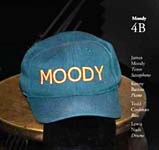 4B 4B
IPO
Recordings
By Tom
Ineck
Like its
predecessor, 2009’s “4A,” the latest release by the James Moody Quartet
is a scintillating swinger showcasing the continued brilliance of the
83-year-old tenor saxophonist and his sensitive sidemen—pianist Kenny
Barron, bassist Todd Coolman and drummer Lewis Nash. Also recorded
during two sessions on consecutive days in July 2008, it is proof
positive of the foursome’s consummate compatibility and prolific
creativity during that brief stay in the studio.
Barron
launches the proceedings with a stately stride piano introduction before
the rest of the band takes kicks in with a swinging version of “Take the
A Train.” Moody soon is soaring through variations on the familiar
changes, followed closely by an equally brilliant Barron solo and some
well-chosen percussion permutations by Nash. Tadd Dameron’s “Hot House”
is taken at mid-tempo rather than the usual frenetic pace, but it serves
Moody and company well as they darken the harmonies and explore the
tune’s more mysterious implications, especially notable in Coolman’s
solo.
Perky Latin
rhythms pervade “Speak Low” and provide a fruitful framework for solo
statements by Moody and Barron. Romance is in the air on “Polka Dots and
Moonbeams,” as Moody squeezes every drop of lush balladry from this
beloved standard over its nearly 10-minute length. Cole Porter’s “I Love
You” also gets the Latin treatment with Coolman and Nash creating a
subtle, but infectious rumba underpinning as Moody and Barron float
above on solo flights.
Two
excellent originals are a welcomed contrast to the familiar tunes.
Coolman’s “O.P. Update” is a tribute to bassist Oscar Pettiford based on
the changes to Ellington’s “Perdido.” All members of the quartet have
ample solo space. Barron’s granddaughter was the inspiration for his
composition “Nikara’s Song,” a tender, relaxed tune that allows both
Moody and Barron to express deep-seated emotions as Coolman repeats a
pulsating bass line.
Benny
Golson’s “Along Came Betty” gets a bright and swinging treatment greatly
aided by the inspired rhythm section. Nash’s brushwork embellishes an
elegant rendition of Gershwin’s “But Not for Me,” which features an
early Coolman solo setting the stage for Moody’s confident entry on
saxophone.
As with the
first product of these sessions, the quartet’s performances here are
another reminder of Moody’s many contributions to the jazz art form and
his continued ability to excite and inspire his colleagues and his fans.
top |
|
|
|
MASON BROTHERS
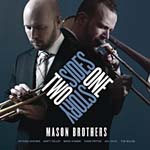 Two
Sides, One Story Two
Sides, One Story
Archival
Records
By Tom
Ineck
Native
Britons, the Mason brothers—trumpeter Brad and trombonist Elliott—have
been making waves on this side of the pond since they came to America in
the early 1990s on scholarships to the Berklee College of Music. Neither
has been short of work since they graduated and moved to the Big Apple,
but “Two Sides, One Story” is their first recording as leaders. It’s a
stunning debut.
Over the
years, the Masons have assembled impressive resumes. Elliott has worked
with the Mingus Big Band, the Count Basie Orchestra, the Maria Schneider
Orchestra and Jazz at Lincoln Center Orchestra, under the direction of
Wynton Marsalis, who wrote the liner notes for this release. Brad has
racked up experience with Natalie Cole, Mike Stern, Randy Brecker,
Lionel Loueke and, since 2007, in rock singer-songwriter John Mayer’s
band. Those varied connections probably help account for the fact that
they have gathered some of the best sidemen available for this
project—including the rhythm section of pianist David Kikoski, bassist
Scott Colley and drummer Antonio Sanchez, and guest soloists saxophonist
Chris Potter, vibraphonist Joe Locke and guitarist Tim Miller.
“Two Sides,
One Story” is an excellent showcase for the Masons, not only their
playing prowess and band-leading talents, but their gifts as composers
and arrangers. They wrote all eight tunes here.
The
co-written “24/7” (24 bars ending with a 7/4 vamp) seems to reveal new
wonders with every listen. Its sound is progressive and its mood is
strictly optimistic as the rhythm section swaggers and the horns
interlock. Elliott takes a brawny trombone solo before handing it off to
Brad for a more introspective trumpet statement. Brad opens “Stage
Pints” with some trumpet ruminations over a sophisticated drum vamp
before the rest of the band goes into the tune, whose title is an
anagram of “Giant Steps.” Composer Elliott takes an incredible, extended
solo through the new, re-harmonized changes, alternating between 3/4 and
4/4 time. Potter goes ballistic on a brilliant tenor solo. You get the
idea. This is a very complex—but fun—exercise in music-making.
Things
return to a more subdued mood for the title track, penned by Elliott.
Again, the title reflects the form in which it is written, with mirror
melodies converging, one passively and one more aggressively. In other
words, we hear two sides of the same story. The rhythm section expertly
maintains a stately and dramatic splendor throughout. “The Evil Eye” is
a tune by Elliott commissioned for the soundtrack of a silent film by
German director Hans Richter called “Filmstudie.” Colley’s bass sets up
a dirge-like introduction as the tune builds in intensity, spinning and
leaping in frenetic shards of sound. Miller enters on guitar with an
abstract flourish of notes, Elliot triple-tongues through a rapid-fire
trombone solo, Brad inserts percussive trumpet blasts, Kikoski adds his
own edgy punctuation and Sanchez keeps the whole thing churning
rhythmically. It is a dark and disturbing masterpiece!
After so
many years in the states, the Masons have mixed feeling about their
definition of home, and that ambivalence comes through forcefully on
Elliot’s sad and beautiful ballad “Gone Home,” which features Locke’s
lovely, understated playing on vibes and a mournful trombone-trumpet
interlude. The brothers were searching for a positive, uplifting tone
when they wrote “Outside In,” and they found it in the blues. The tune
shuffles and swaggers in mid-tempo, giving the rhythm section a chance
to show how well the work together. Brad’s early solo brightly flashes
and Elliott follows with gusto on trombone.
“Boots” was
written and first recorded by the Masons back in 1996, but was updated
here for an acoustic approach. Colley’s constantly moving bass line is
at the core, with the others weaving lines around it. Elliott turns in
an astounding trombone solo. “In the Third Person” triples the fun with
three interweaving melodies operating at breakneck speed. Potter joins
the Masons on tenor, but the tune also takes advantage of Kikoski’s
great keyboard skills, Colley’s precision bass-playing and the whirlwind
polyrhythm of Sanchez.
We
anxiously await the next chapter of “Two Sides, One Story.”
top |
|
|
|
BRAD GOODE
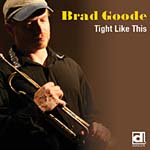 Tight
Like This Tight
Like This
Delmark
Records
By Tom
Ineck
I first
heard trumpeter Brad Goode in his hometown, as a featured player at the
1988 Chicago Jazz Festival. At age 25, he looked more like 15 and had
just release his debut recording on Delmark, “Shock of the New.” A
friend and I dubbed him “Baaaad Goode” for his extraordinary technique
and funkiness.
That funk
factor also permeates Goode’s fourth and latest Delmark release, “Tight
Like This.” It is evident from the opening title track’s earthy
backbeat, provided by drummer Anthony Lee and reinforced by pianist
Adrean Farrugia and bassist Kelly Sill. This is definitely NOT just
another slavish cover of the classic by Louis Armstrong, although Goode
proves he is capable of squeezing off piercing, Satchmo-style high notes
and glissandi during his climactic solo.
Goode
delves again into the classic repertoire of early jazz with “Changes,” a
Bix Beiderbecke feature from 1927 that gets a distinctly polyrhythmic
interpretation, full of interesting twists and turns. Farrugia boldly
explores harmonic variations as Lee keeps things interesting with some
exciting percussion, occasionally inserting some nifty New Orleans
street beats. “Nightingale” gets a sensuous rumba treatment with Goode
stating the theme, then galloping with obvious delight through the
changes on a Harmon-muted horn. Farrugia and the trumpeter later urge
each other on with some clever variations.
Another old
standard, “Reaching for the Moon,” gets a bop-oriented update as Goode
sails along on open trumpet, figuratively “reaching for the moon” while
alternately accelerating and slowing the tempo. Lee easily keeps the
pace through some tricky twists and turns and even adds to the urgency
as Farrugia turns in a dazzling solo. The rhythm section applies a funky
backbeat to Freddie Webster’s feel-good “Reverse the Charges,” on which
Goode again employs a mute.
The
trumpeter contributed five of his own compositions to the session.
“Summary” is dedicated to Goode’s late mentor, Eddie Harris and features
another outstanding solo by Farrugia. Again on muted horn, Goode sounds
elegiac on the lovely “Midwestern Autumn,” a meditative number with
superb solo statements by Sill and Farrugia. The band boldly ventures
into abstract territory on “Climbing Out,” then returns to soulful
gospel-style roots with “The River.” Delmark Records founder and
producer Bob Koester gets an appreciative nod on “Bob’s Bounce.”
Farrugia
wrote the inspired arrangement of “Softly, as in a Morning Sunrise” that
closes the CD. It surges with a rhythmic tension and interesting
counter-harmonies. The arranger delivers an outstanding solo, followed
by Goode’s even more spectacular solo, all propelled by Sill and
especially Lee in a mounting polyrhythmic barrage.
top |
|
|
|
ROYCE CAMPBELL TRIO
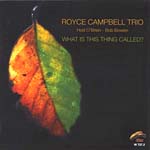 What
Is This Thing Called? What
Is This Thing Called?
Philology Jazz
By Tom
Ineck
Jazz
musicians frequently deconstruct and reimagine the standards of the
Great American Songbook, even superimposing new melodies over the
original chord structures until the process begs the question: Why not
alter the titles to reflect the changes? That’s exactly what guitarist
Royce Campbell has done on a couple of previous CDs as well as his
latest release, cleverly titled “What Is This Thing Called?”
Essentially, Campbell has written 11 new tunes, but the titles are a
tipoff to the familiar tunes that inspired them. “Love for Rent” is a
nod to “Love for Sale,” the ballad “I Fall in Love Too Hard” is the
inevitable reply to “I Fall in Love Too Easily,” and the title track is
an obvious reference to “What Is This Thing Called Love?” You get the
idea.
In his
effort to revisit familiar territory in new and interesting ways, the
guitarist is joined by longtime colleague Bob Bowen on bass and the
wonderful pianist Hod O’Brien, who the Berman Music Foundation brought
to Lincoln with singer Stephanie Nakasian for an October 2001
performance at P.O. Pears. For a more intimate sonic production, the CD
was recorded in the cozy confines of O’Brien’s living room, with the
pianist performing on a small upright.
O’Brien
confidently navigates through the classic changes of “I Got Rhythm” for
a swinging revamp called “They Had Rhythm,” perhaps a sly reference to
the good old days when it wasn’t jazz unless it swung with feeling.
Campbell and O’Brien both solo with verve and imagination. Only the name
of the protagonist changes for “Have You Met Miss Smith?” a well-paced
opportunity for Campbell and O’Brien to listen and respond to each
other’s ideas. All the players stretch out on “See Jam Blues,” an
oblique reference to Ellington’s “C Jam Blues.”
Among other
tell-tale titles are the egotistical “How About Me,” the fictitious “I
Could Write a Novel,” the very public “Not So Secret Love” and “In a
Sorta Mental Mood,” a somewhat psychologically unbalanced take on the
Ellington evergreen “In a Sentimental Mood.” Actually, the titles are
less indicative of the various moods involved than they are of
Campbell’s playful sense of humor.
Campbell,
O’Brien and Bowen shine even without the presence of a grand piano or
the state-of-the-art sound of a professional recording studio. The
drummerless trio gains in intimacy what it lacks in a more conventional
studio setting.
“What Is
This Thing Called?” comes on the heels of two Campbell releases recorded
just six weeks apart, in late 2008 and early 2009. In fact, we reviewed
those CDs earlier this year, proof that Campbell continues to produce
noteworthy music at a prolific rate.
top |
|
|
|
JEFF BECK
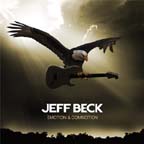 Emotion
& Commotion Emotion
& Commotion
ATCO
Records
By Tom
Ineck
What the
listener immediately notices about the new Jeff Beck CD is its “lyrical”
beauty, the guitarist’s ability to “vocalize” with his instrument. Every
solo sounds like an aria for guitar—a “guitaria.”
Beck’s
eccentric six-stringed forays have always had an element of heartfelt
lyricism, from his early days with the Yardbirds and the fuzz-toned
psychedelia of “Heart Full of Soul,” “Shapes of Things,” and “Happenings
Ten Years Time Ago.” His mid-1970s solo recordings eschewed conventional
vocals entirely, allowing his guitar to assume the role with gorgeous
instrumental versions of Stevie Wonder’s “Cause We’ve Ended as Lovers,”
Lennon and McCartney’s “She’s a Woman,” and Charles Mingus’ elegy for
Lester Young, “Goodbye Pork Pie Hat.” The brilliant 2008 recording
“Performing This Week… Live at Ronnie Scott’s” made it abundantly clear
that Beck had lost nothing in the way of technique or emotional wallop,
and his first studio recording in seven years, “Emotion & Commotion,”
reaffirms that fact while adding to his stature as the greatest rock
guitarist of all time.
It opens
modestly, with Beck’s guitar movingly singing the melody of Benjamin
Britten’s “Corpus Christi Carol,” with keyboards and orchestral
arrangement by Pete Murray, who adds similar lush touches throughout the
recording. Beck’s version was inspired by that of another J.B., the late
Jeff Buckley, who recorded the tune on his 1994 debut, “Grace.” Lasting
less than three minutes, it abruptly segues into “Hammerhead,” a typical
Beck rocker based on an irresistible riff by keyboardist Jason Rebello,
with Tal Wilkenfeld on bass and Alessia Mattalia on drums. Beck uses the
repeated phrase as a springboard for one of his exciting, fuzz-toned
flights into the stratosphere.
Rebello
achieves a truly vocal sound on his gorgeous composition “Never Alone.”
Beck, of course, takes the lead “voice,” spinning his guitar magic
around the chord changes. Perhaps the CD’s most obvious attempt at
lyrical precision is the guitarist’s stunning take on the classic “Over
the Rainbow,” a yearning, moaning performance aided again by Murray’s
orchestral flourishes.
Beck
returns to his bluesy roots on a brief rendition of the Screamin’ Jay
Hawkins tune, “I Put a Spell on You,” sung with great emotion by Joss
Stone. “Serene” is what the name implies, a meditative melody by Beck
and Rebello that also features atmospheric vocalizing by Olivia Safe and
some soaring, but sensitive slide guitar work. Singer Imelda May
beautifully interprets another Buckley favorite, the poetic 1949 love
song “Lilac Wine,” usually associated with Nina Simone’s definitive
version. Again Beck makes it his own with touching lyricism, which leads
naturally into the astounding “Nessum Dorma,” a Puccini aria that gets
the full orchestral treatment to great effect. Beck’s final notes are
heavenly.
Joss Stone
returns on the soulful “There’s No Other Me,” for which she also wrote
the lyrics to Rebello’s composition. Halfway through this four-minute
song and again at the fade, Beck tempting injects short shredding solos,
but otherwise confines himself to able accompanist. Dario Marianelli’s
“Elegy for Dunkirk” is another guitar-vocal collaboration with the
operatic Safe, whose wordless vocal interlude enters as a light into the
moody darkness. Beck seems inspired to find that same hopeful brightness
in his solo.
Yes, Beck’s
latest produce is more emotion than commotion. That may disappoint some
fans who were hoping for more rock-oriented guitar shredding, but the
sheer beauty of “Emotion & Commotion” is undeniable.
top |
|
|
|
CLAUDIO RODITI
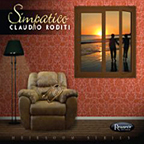 Simpatico Simpatico
Resonance Records
By Tom
Ineck
A favorite
of the Berman Music Foundation since the BMF brought him to
Lincoln with saxophonist Greg Abate in 1996, Brazilian trumpet virtuoso
Claudio Roditi has followed up his 2009 Resonance Records debut with
“Simpatico,” another sterling example of Roditi’s bop-oriented Latin
jazz.
Whether on
trumpet, flugelhorn or piccolo trumpet, his playing always maintains a
high level of excitement and his recordings are never less than
dazzling, consistently satisfying and imaginative. In this case,
“Simpatico” may refer both to Roditi’s close association with the
material—he composed all of the 12 tunes—and his compatibility with the
other players. Among them are young trombonist Michael Dease, guitarist
Romero Lubambo, pianist Helio Alves, bassist John Lee and drummer Duduka
da Fonseca.
The
sympathetic nature of the project is evident from the first track, the
jumping and joyous “Spring Samba.” Roditi moves through the difficult
changes with bright and breezy abandon, followed by an equally adept
trombone solo by Dease. Alves and da Fonseca also get solo statements
that ensure their rhythmic credentials. “Alfitude” is a beautiful bossa
that celebrates underappreciated Brazilian composer Johnny Alf. Roditi
and Dease harmonize their horns in lush precision.
Roditi
utilizes a muted piccolo trumpet to good effect on the aptly entitled
“Piccolo Blues.” The smaller horn is not only in a higher register but
creates more resistance for the player, making it a difficult instrument
to play, but the effort pays off here. One of Roditi’s minor
masterpieces, the ballad “Slow Fire” is the title track of his 1989
release. Here it gets the full orchestral treatment with an arrangement
by Kuno Schmid and the composer pouring out his heart on flugelhorn.
“How
Intensitive” is a variation on Jobim’s standard “How Insensitive.”
Roditi’s flugelhorn deftly navigates the tricky changes at a medium
tempo before turning it over to Lubambo for a delectably tasteful solo
on the nylon-stringed acoustic. “A Dream for Kristen” is a loving
tribute to Roditi’s wife on which Lubambo switches to electric steel
strings for some Wes Montgomery-style chording.
Keeping it
all in the family, Roditi continues with “Alberto and Daisy,” a
light-hearted samba dedicated to his parents. Alves also shines on his
imaginative piano solo, and da Fonseca makes another breath-taking drum
statement. Roditi and Dease meld their horns again on “Blues for Ronni,”
with Dease taking a brawny and blustery solo. A da Fonseca drum solo
sets the pace and the mood for “Slammin’,” a blistering cycle of changes
that everyone handles with seeming ease.
Roditi
lends an engaging sensitivity to his vocal on “Waltz for Joana” before
taking over the theme on muted trumpet. Both Alves and Lubambo
contribute brief, but lovely solo variations leading to the vocal
reprise. “Vida Nova (New Life)” is referred to by the composer as “Zen
Samba.” It does, indeed, seem effortless and elemental in its execution,
thanks to flawless solos by Alves, Roditi and Lubambo. The drummer again
sets the stage with a percussion introduction to the fast-paced finale,
“Winter Dreams.” Roditi’s generosity with his fellow musicians
throughout this project seems to bear out its title.
top |
|
|
|
DEE DEE BRIDGEWATER
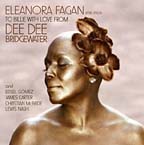 Eleanora
Fagan: To Billie with Love Eleanora
Fagan: To Billie with Love
DDB
Records
By Tom
Ineck
At age 60,
Dee Dee Bridgewater may be the greatest living jazz singer at the
pinnacle of her career, but she has not forgotten the jazz lineage from
which she sprang or the jazz artists who inspired her. “Eleanora Fagan”
is the latest in a string of tributes that also include 1995’s “Love and
Peace” collection of Horace Silver tunes, and 1997’s homage to Ella
Fitzgerald called “Dear Ella.”
A sprightly
personality with a more virtuosic voice than Holiday possessed,
Bridgewater does not attempt to mimic the great “Lady Day.” Her style is
closer to that of Betty Carter, Sarah Vaughan or Ella. But there is no
doubting Bridgewater’s profound respect for Holiday’s tragic genius and
her unmatched ability to put a song across with emotion. She is aided in
this effort by the arrangements of pianist Edsel Gomez and the
accompaniment of bassist Christian McBride, drummer Lewis Nash and the
multi-instrumental reed master James Carter.
Appropriately, “Lady Sings the Blues” kicks things off with a Holiday
original that leaps with rhythmic counterpoint and lyrics that introduce
the subject with an autobiographical story line. Carter accompanies with
bluesy urgency on tenor sax. Most of the remainder of the CD contains
standards that were prominent in Holiday’s repertoire. Bridgewater
joyfully scats through the brisk “All of Me,” with Carter on soprano.
She caresses the blues-tinged “Good Morning Heartache” as Carter’s
quavering bass clarinet plumbs the lower depths of the lyric’s despair.
Her rendition of “Lover Man” is alternately wistful and hopeful.
Carter
wails on the mournful “You’ve Changed,” as the rhythm section provides a
rock-solid canvas for Bridgewater’s painterly vocal colors. The
two-minute “Miss Brown to You” demonstrates the singer’s talent for
swinging swagger and mischief as she sets up Lewis for a drum solo and
Carter soars overhead on tenor. Carter’s flute is the perfect foil for
Bridgewater’s shadowy voice on “Don’t Explain.”
McBride is
in his bluesy Ray Brown mode as he sets up the walking bass line on
“Fine and Mellow,” Holiday’s trademark composition. At Bridgewater’s
urging, Carter enters the fray on tenor, going uptempo in a thrilling
solo. The clever “My Mother’s Son-in-Law” showcases an unbridled
dialogue between McBride’s playful bass and Bridgewater’s suggestive
vocals. Holiday’s most famous original, “God Bless the Child,” gets a
respectful reading that emphasizes the lyrics of self-determination,
while giving Carter a chance to shine on soprano sax.
After a
faithful recital of the introductory verse with piano accompaniment
only, Bridgewater launches into a swinging version of Gershwin’s “A
Foggy Day” replete with irrepressible scat-singing and some fleet piano
work by Gomez. Holiday’s own struggle with racism and personal
acceptance are reflected in Lewis Allen’s “Strange Fruit,” which Holiday
performed to spellbound audiences and which makes for a powerful closer
to this collection. A veteran of the theatrical stage, Bridgewater
dramatically evokes a public lynching in a voice that cracks as she
describes the scene in gruesome detail.
top |
|
|
|
STEVE KUHN TRIO with JOE LOVANO
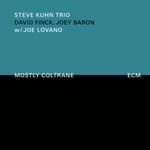 Mostly
Coltrane Mostly
Coltrane
ECM
Records
By Tom
Ineck
Pianist
Steve Kuhn gets short shrift in most jazz commentaries, where he’s
usually identified as the guy who preceded McCoy Tyner in John
Coltrane’s classic quartet. As his tenure in that ensemble lasted only
two months, the reference does Kuhn a disservice and relegates him to
little more than a footnote in history. On the contrary, the 72-year-old
Kuhn also played in the bands of Stan Getz and Art Farmer and has
produced a string of wonderful recordings under his own name over the
years. The most recent evidence of his staying power is “Mostly
Coltrane,” a tribute to his former employer featuring the sympathetic,
Trane-like tenor of Joe Lovano and Kuhn’s exemplary trio mates David
Finck on bass and Joey Baron on drums.
The 13
tracks included here are largely Coltrane originals and wide-ranging
examples of his incredible impact on the evolution of modern jazz and on
the development of the tenor sax as its most iconic instrument.
“Welcome” is a relaxed meditation, while the bluesy “Song of Praise” is
a more passionate spiritual exploration, with Lovano delivering the
theme in a high, keening tone. Their take on the lovely “Crescent” is
carefully measured as Kuhn creates lush keyboard soundscapes for
Lovano’s gorgeous passages and Baron tastefully uses mallets on cymbals.
Billy
Eckstine’s ballad “I Want to Talk About You” and the standard “The Night
Has a Thousand Eyes” are the only tunes not written by Coltrane or Kuhn.
Lovano sits out the first one, allowing the trio to fully work the
variations suggested by the beautiful chord changes. The trio opens the
latter tune, taking it uptempo to a blistering pace before Lovano makes
his entrance with burry gusto about halfway through the nine-minute
burner, and his explosive attack urges Kuhn, Finck and Baron to new
heights.
“Living
Space” is a dreamy, rhythmically free exploration that allows all
players to express themselves. By contrast, it is followed by “Central
Park West,” one of Coltrane’s most mellow and memorable melodies. Lovano
brilliantly finds the common ground between Coltrane and Rollins on the
Latin-tinged “Like Sonny,” which is also a springboard for superb solo
statements by Finck and Baron.
Kuhn penned
the piano solo piece “With Gratitude” as a personal homage to Coltrane.
“Configuration” is an obscure Coltrane tune given a raucous free-jazz
interpretation, first by Lovano and Baron, then adding Kuhn and Finck to
the fray. Another rarity, “Jimmy’s Mode,” gets a more meditative reading
and allows the players to make their statements in more orderly fashion.
On the bluesy “Spiritual” Lovano switches to tarogato, a Hungarian reed
instrument that sounds a bit like soprano sax. The CD closes with
“Trance,” another beautiful solo piano tribute by Kuhn.
Not
surprisingly, the mood throughout this Coltrane tribute is alternately
respectful, relaxed, intense and spiritually transcendent, adhering both
to the ECM reputation and the legacy of John Coltrane. With “Mostly
Coltrane,” Kuhn also delivers one of his most heartfelt recordings.
top |
|
|
|
THE STRYKER/SLAGLE BAND
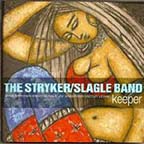 Keeper Keeper
Panorama
Records
By Tom
Ineck
The latest
release from longtime friends and collaborators Dave Stryker and Steve
Slagle is another adventurous exploration of the deep groove, common
ground where the guitarist and saxophonist are again joined by bassist
Jay Anderson and drummer Victor Lewis to create a magical group sound.
Stryker’s
edgy guitar lines blend seamlessly with Slagle’s sax, as the rhythm
section churns beneath. This high degree of compatibility is not
achieved overnight and is a tribute to the sensitive, four-way
communication on display throughout “Keeper.” Stryker’s catchy opening
title track aptly defines the entire project, as he works the funky
guitar chords, Slagle matches the melody line with short alto bursts,
and Lewis reaffirms his standing as a world-class percussionist who is
never at a loss for ideas.
Never too
far from the blues, the band swings with bluesy feeling on Slagle’s
“Bailout,” wherein the composer and Stryker contribute equally
compelling solos, then trade fours with customary glee before returning
to the theme. The only cover tune here is Monk’s familiar ballad “Ruby
My Dear,” and it gets a sensitive reading by Slagle, with lush, chorded
harmonies by Stryker. “Come to Believe” contains an irresistible groove
with also sax and guitar doubling the main theme before Stryker and
Slagle each cut loose with a solo, aided and abetted by Lewis and
Anderson.
“Bryce’s
Peace” is a lovely Slagle-penned ballad that perfectly demonstrates the
natural ease with which these players interact. Slagle takes the lead,
Stryker’s gentle, Metheny-like comping is subtlety personified, Lewis
tastefully uses the brushes and Anderson is especially notable for his
relaxed, inspired solo. With Stryker’s cleverly titled “Blue State” we
find ourselves seated front and center at an imaginary blues club, where
the foursome are getting down and dirty. The outlook brightens with
Slagle’s snappy uptempo “Sister,” a great vehicle for Stryker’s
Wes-tinged guitar chording and a joyous workout for Lewis and Anderson,
who takes a sublime solo.
“Gold Dust”
is a minor-key gem that manages to evoke a kind of hopeful melancholy.
Stryker takes a rare and wonderful solo on acoustic guitar, followed by
Slagle on soprano sax. Stryker’s unusual “Convergence” again features
Slagle on soprano as the guitarist returns to the electric six-string
for some breathtaking fretwork and Lewis takes a signature solo of great
imagination and fire. The closer is “Good 4 U,” a lively Latin tune by
Slagle that again documents the all-round camaraderie and technical
proficiency of these four individuals.
top |
|
|
|
JOE CHAMBERS
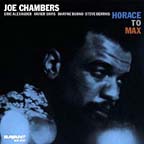 Horace
to Max Horace
to Max
Savant
Records
By Tom
Ineck
A stalwart
session player since the mid-1960s, drummer and vibraphonist Joe
Chambers has only recently renewed his reputation as a bandleader of
considerable skill and imagination. “Horace to Max” is Chambers’ second
excellent CD on the Savant label, a follow-up to 2006’s “The Outlaw.” As
the title of the new release implies, it is homage to the funky,
Afro-Caribbean music associated with Horace Silver and Max Roach.
Kenny
Dorham’s brawny “Asiatic Raes” starts things in a hard-bop style, led by
the driving drums of Chambers, the swaggering tenor sax of Eric
Alexander and the propulsive rhythmic support of pianist Xavier Davis,
bassist Dwayne Burno and conguero Steve Berrios. Chambers switches to
vibes and Berrios takes over the drum chores on Silver’s beautiful
ballad “Ecorah.” “Man from South Africa” is a Roach composition with
Chambers doubling on drums and vibes in the richly harmonized theme. As
always, Alexander’s tenor playing is superb.
Nicole
Guiland makes a guest appearance singing the overtly political lyrics of
Roach’s “Mendacity,” from the drummer’s 1961 classic “Percussion Bitter
Sweet.” Evoking the original recording as sung by Roach’s former wife,
Abbey Lincoln, Guiland cynically sings, “The campaign trail winds on and
on, in towns from coast to coast. The winner ain’t the one who’s
straight, but he who lies the most.”
Marcus
Miller wrote “Portia” for the 1986 Miles Davis project “Tutu,” and it
gets a respectful reading with Chambers doubling on vibes and marimba,
and taking a stunning solo on the latter instrument. Davis and Alexander
also contribute atmospheric solo statements. Another subtle reference to
Miles is “Water Babies,” a lilting, whimsical Wayne Shorter tune that
served as the title track of a 1977 Davis release. Here, Chambers covers
all the bases on vibes, marimba and drums as Alexander’s tenor leaps
through the changes.
Guiland
returns for a glowing rendition of the bluesy “Lonesome Lover,”
co-written by Roach and Lincoln for a 1962 record. Chambers gives a
respectful nod to Thelonious Monk with a brisk version of his
rhythmically complex “Evidence.” Again, Alexander excels in the
confident, honking style of Sonny Rollins. Chambers’ own “Afreeka”
confirms his latest project’s Afrocentric nature with its roots-derived
percussion “dialogue.” More than ever, Chambers emphasizes the ringing,
melodic sounds of the vibes and marimba and downplays his work on drums,
allowing Berrios to provide much of the percussion. The result is a very
satisfying listen.
top |
|
|
|
JEFF JENKINS
 The
Healing The
Healing
Mile
High Music
By Tom
Ineck
Listening
to “The Healing” is an intimate act, as though catching a glimpse of
someone in the process of a slow, painful recovery. Solo pianist and
composer Jeff Jenkins admits as much in the liner notes. As he writes,
“I’ve seen loss and disappointment, illness and death, divorce,
marriage, addiction and recovery, depression and hope.”
A
Denver-based musician and educator, Jenkins is a Nebraska native who
still maintains ties with the state. Earlier this year, he returned to
Lincoln for an indoor Jazz in June performance with trumpeter Darryl
White’s band. The best evidence of recovery and hope in Jenkins’ own
life is his recent marriage to Terri Jo, who left Lincoln last year for
a new life in the Rockies.
“The
Healing” opens meditatively with “The Three Flames (for Frank).” Its
melancholic theme occasionally allows for a shaft of light to break
through the darkness as Jenkins ranges over the keyboard with
Chopinesque soulfulness. “End of Sides” is brisker and brighter in tone,
setting a lilting melody against dark chords. The moody “Inside Out” has
a more tentative, unresolved conclusion, while “Lost Waltz,” for all its
initial sadness, gives us hope that all is not lost. Perhaps that is the
message of every waltz, with its inherent lilt and irresistible swing.
At least, Jenkins treats it that way here.
Sometimes
all that healing requires is a “Second Chance,” and the gorgeous changes
of this one do have peaceful, healing qualities. Though the title of
“Highlife” may allude to a life of revelry, I prefer to think of it as a
celebration of the clean, high-altitude living in Jenkins’ adopted
state. He gives it a soulful gospel strut that is undeniably positive in
its outlook. Amen!
“Song for
Jo” is the composer’s tender tribute to his wife. Again, the listener
feels a little voyeuristic being allowed to witness such an intimate and
heartfelt expression of love. Despite its dedication to “Lee,” we can
all take comfort in the uplifting, pastoral balm of “The Healing Hymn.”
With “Waltz for Ellington,” Jenkins pays homage to the quintessential
bandleader, again conveying the sense of swing in three-quarter time as
he explores variations on the theme.
With its
bold, sustained chords, spiritual aspiration and firm resolution, “El
Sanctuario” does, indeed, feel like a place of refuge from the storms of
life. By layering improvised lines, Jenkins reinforces that sense of
safety and self-assurance. “The Girl with the Soulful Eyes (for Zoe)” is
an expression of pure syncopated joy, allowing us a brief glimpse of
this marvelous creature. Jenkins closes by returning to a more
introspective mood on “The Goodbye Season,” as though reluctantly
closing a door on the past while opening a new one to the future.
top |
|
|
|
OLIVER JONES / HANK JONES
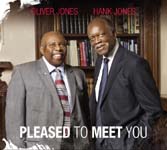 Pleased to Meet You Pleased to Meet You
Justin
Time Records
By Tom
Ineck
For poise,
sophistication, technique and taste, no one can keep up with the
Joneses. That is, Oliver Jones and Hank Jones, who join their talents
here for a momentous collaboration that is as much memorial homage to
Oscar Peterson as it is testimonial to their own, enduring reputations.
“Pleased to
Meet You” was in the planning stages when Peterson died in December
2007. It was recorded in June 2008 in Montreal, the hometown of both
Peterson and Oliver Jones and—aptly—appears on the Justin Time label, a
Montreal-based company with which Oliver Jones has been associated for
more than 25 years. The result is a relaxed, genial atmosphere that
comes across on the recording, the first featuring these two keyboard
giants.
Hank Jones,
almost 90 at the time of this recording, is Oliver’s senior by about 17
years, but their styles are eminently compatible. That is especially
apparent on the opener, the stately Ellington tune “What Am I Here For?”
where they build the melody line at a gentle, strolling gait. The
soulful Jerome Richardson standard “Groove Merchant” fully exploits the
blues influence in both pianists, capably abetted by bassist Brandi
Disterheft and drummer Jim Doxas, who are aboard on the first three
tracks only. The last of these is “Ripples,” a delightful Hank Jones
romp that features Disterheft and Doxas trading solo breaks.
The rhythm
section steps down as the pianists go head-to-head on “Makin’ Whoopee.”
The Joneses illustrate the rare ability to listen and respond
appropriately, never getting in each other’s way as they “converse.” On
the uptempo “I’ll Remember April,” one delineates the theme while the
other provides a rubato introduction, then they each go on dazzling solo
flights before returning to the melody. Another tune that suits the duo
well is “Star Eyes,” with its intriguing changes and lush chords.
The elder
Jones has two brief solo features, including “Monk’s Mood,” and the
closer, “Lonely Woman,” a moody piece by William Stegmeier that clocks
in at less than two minutes.
The
spotlight turns squarely on Peterson with his “Blues for Big Scotia,” a
broad, two-fisted blues composition that allows both of the Joneses to
show their chops as they trade solos and keep the powerful groove
churning. Peterson’s “Cakewalk” is a more light-hearted affair, bouncing
along and keeping both pianists on their toes. But it is Oliver Jones’
“I Remember OP” that most intimately pays the duo’s respects to their
late friend and fellow piano legend.
top |
|
|
|
MATT WILSON QUARTET
 That’s
Gonna Leave a Mark That’s
Gonna Leave a Mark
Palmetto
Records
By Tom
Ineck
As the
title so cleverly implies, the latest release from the Matt Wilson
Quartet definitely leaves an impression on the listener. Whether you’re
new to the Wilson esthetic or a long-time fan, “That’s Gonna Leave a
Mark” is a tantalizingly unique experience. For those in the know, its
blend of catchy melodies, free-bop improvisations, rhythms that
alternately swing and rock with a backbeat, and an overall sense of
whimsy are typically unconventional—or is that unconventionally typical?
Over the
course of his 14-year relationship with Palmetto Records, the wily
drummer has consistently maintained a quartet format, sometimes with
saxophone, keyboards and bass, sometimes with trumpet and keys, and
sometimes with two saxophones and bass, which is the case here, with
Andrew D’Angelo and Jeff Lederer on assorted reeds and Chris Lightcap on
bass. His current touring foursome, which performed March 26 in Lincoln,
changes that equation yet again by pairing saxophone and trumpet.
D’Angelo on
alto sax and Lederer on tenor sax manage to sound like a whole brass
section while setting up the opening romp, “Shooshabuster,” before
engaging in solo excursions, with shouted encouragement from Wilson.
“Arts and Crafts,” the stop-and-start title track of Wilson’s 2001
release, is given a new lease on life as the two saxophones harmonize
then merge with Wilson’s insistent snare-drum pulse for a three-way
dialogue. This recording is dedicated to bassist Dennis Irwin, a former
Wilson bandmate who died a couple of years ago.
D’Angelo’s
“Rear Control” features Lederer soaring on clarinet, as the tempo
escalates. The time signature shifts again, and the composer joins the
fray on bass clarinet. “Getting Friendly” is a sweetly melodic love song
penned by Wilson. The quartet has a ball interpreting the bebop classic
“Two Bass Hit” by the MJQ’s John Lewis. Lederer growls on tenor,
Lightcap prowls on bass and Wilson drives the tempo and skips lightly
over the changes in a bravura percussion performance.
A heavy
backbeat moves Wilson’s “Area Man,” while saxophones combine in raucous
abandon. Lederer’s daughter, Maya, choose 12 notes that her dad then
fashioned into the beautiful chamber piece for clarinets called “Lucky.”
As Wilson writes in the liner notes, it is a song that “resounds of
honesty, hope and optimism.” The brief title track has Wilson roving
over the drum kit like a man possessed as Lederer and D’Angelo make
their impression with a vengeance. Lightcap contributed the lilting
free-bopper “Celibate Oriole” to the quartet’s songbook.
The
traditional 19th century hymn “Come and Find the Quiet
Center” and the 1974 song by War called “Why Can’t We Be Friends?” close
the recording on a note of contemplation and world unity, with “The
Swayettes” and the entire Wilson family joining in on the final tune’s
vocal chorus.
top |
|
|
|
GENE HARRIS QUARTET
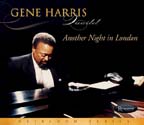 Another Night in London Another Night in London
Resonance Records
By Tom
Ineck
With
“Another Night in London,” Resonance Records continues to pay homage to
the lasting legacy of piano great Gene Harris, whose career was revived
in the 1980s and 1990s with nearly 20 releases on the Concord label,
extending right up to his death in early 2000. Always an exciting
keyboard stylist with roots deep in the blues, Harris is at his most
riveting in concert with a quartet. Such is the case here, another set
from his 1996 club date at Pizza Express. Resonance released the first
volume, “Live in London,” in 2008.
Like that
previous CD, “Another Night” showcases six extended performances with a
solid band consisting of Scottish guitarist Jim Mullen (of Brian Auger’s
Oblivion Express and Average White Band) and two Brits, bassist Andrew
Clyendert and drummer Martin Drew, who worked extensively with Oscar
Peterson. In tracks ranging from eight minutes to more than 13 minutes,
they delve intensely into such soul classics as “Sweet Georgia Brown”
and “Georgia on My Mind,” plus a soulful rendition of the ballad “That’s
All” and stunningly original versions of Jobim’s “Meditation,”
Gershwin’s “Lady Be Good,” and Leon Russell’s “This Masquerade.”
Mullen
ignites “Georgia” with a subtle string-bending introduction, with Harris
taking up the challenge, first with easy-swinging poise then increasing
pyrotechnics and blues power, as the rhythm section intensifies the
groove. “Meditation” gets an especially exciting reading, with Mullen
storming out of the gate and Harris pushing the tempo as he builds
momentum with an inspired flurry of notes. Mullen returns for an equally
outstanding solo.
Harris
deftly teases all the bluesy possibilities from the ballad “That’s All,”
again building to a soul-stirring finish. Perhaps “Lady Be Good” takes
the prize for its raucous and rollicking interpretation, placing Harris
squarely in the pantheon of great jazz keyboard stylists—such as
Peterson and Ray Bryant—who swing with a titanic, two-fisted passion.
Mullen again sets the soulful tone for an exquisitely beautiful take on
“This Masquerade,” with Harris slowly building intensity in less-is-more
style. Mullen’s solo takes off into the stratosphere while maintaining
the tune’s melodic essence.
“Georgia on
My Mind” is just a plain old flag-waver for Harris, incorporating all
the trademark slash-and-burn soul piano technique for which Harris is
known. In the set’s longest performance, he takes chorus after inspired
chorus, never lacking for ideas and never lagging in swinging energy.
The
question now is: Are there any more “Nights” yet to be discovered and
released? If so, Resonance Records is sure to find them.
top |
|
|
|
LAURENCE HOBGOOD
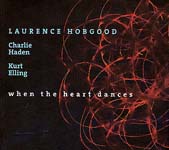 When
the Heart Dances When
the Heart Dances
Naim
Jazz
By Tom
Ineck
Released in
late 2008, this CD pairs idiosyncratic bassist Charlie Haden with
Laurence Hobgood, a pianist best known for his work as accompanist and
arranger for Chicago song stylist Kurt Elling. The piano-bass duo is
favorite setting for Haden, who has recorded similar projects with Hank
Jones, Kenny Barron, Gonzalo Rubalcaba and Chris Anderson. “When the
Heart Dances” joins that elite company as another sterling example of a
jazz “dialogue.”
“Que Sera
Sera” makes for an interesting opener, a promise of more good things to
come. After all, “whatever will be, will be” is a very jazz-friendly
philosophy. Rather than the bright, waltz tempo usually deployed on this
chestnut, Hobgood and Haden give it an introspective treatment. By
contrast, the pianist’s title track is a waltz variation that
beautifully showcases the composer’s keyboard skills.
Elling
joins the duo on three of the 11 tracks here, including the ubiquitous
“First Song,” without a doubt the most frequently recorded Haden
composition. With a haunting melody and lyrics that recount that time
when “love is new,” it is worthy of repeated recordings and a range of
interpretations.
Hobgood
goes solo on two originals. “Sanctuary” is a stately, lyrical piece,
delivered with great emotional impact in a style reminiscent of the best
Keith Jarrett. Haden and Hobgood collaborated on “Chickoree,” a probable
reference to pianist Chick Corea, especially when considering its
leaping, crab-like keyboard meanderings.
Elling
returns for a bold reading of the ballad “Stairway to the Stars,” with
sustained passages where he stretches or repeats words, as though slowly
climbing those stairs, eventually rising to a final falsetto note. Next,
Hobgood dusts off the old Hoagy Carmichael tune “New Orleans” with an
imaginative solo introduction before being joined by Haden for the
ever-so-slow theme.
“Why Did I
Choose You?” is a yearning ballad that gets just the right emotion-laden
treatment from Hobgood and Haden. Hobgood takes a masterful solo turn on
his sprightly composition “Leatherwood.” The tempo slows and Elling
returns for a resonant and resourceful reinterpretation of the
Ellington/Strayhorn classic “Daydream.” Hobgood deftly inserts dark
harmonies as though suggesting an omen of sadness.
The
concluding track is the exquisitely beautiful “The Cost of Living,” by
pianist-composer Don Grolnick. Recorded by saxophonist Michael Brecker
on his 1987 self-named release (with Haden on bass), it was also
included on Grolnick’s 1992 masterpiece, “Nighttown.” Sadly, those
artists have died—the composer at age 48 in 1996 and Brecker at age 57
in 2007. This is a fitting memorial tribute to both.
top |
|
|
|
DANA HALL
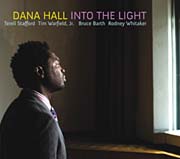 Into
the Light Into
the Light
Origin
Records
By Tom
Ineck
My
introduction to drummer Dana Hall was his March 2009 appearance as guest
soloist with the Nebraska Jazz Orchestra. The concert’s advance
publicity touted his degree in aerospace engineering, music composition
and music arranging, an impressive resume that left me wondering if he
was just another academic who dabbled in jazz.
His
performance that night and his debut recording as a leader, “Into the
Light,” leave no room for doubt. Hall has all the percussion chops,
composing skills and soulfulness that you could ask for, and his
heavyweight bandmates lend him additional credibility. They are
trumpeter Terell Stafford, saxophonist Tim Warfield Jr., keyboardist
Bruce Barth and drummer Rodney Whitaker.
“Into the
Light” begins with Herbie Hancock’s “I Have a Dream,” the only tune not
written by either Hall or one of his band colleagues. Barth’s bright,
harmonic punctuation on Fender Rhodes recall Hancock’s fusion projects
of the late 1960s and early 1970s. Urged along by Hall’s powerful
drumming, Warfield soars into the stratosphere on tenor sax, followed by
an equally exciting solo by Stafford.
The quintet
at times sounds like an updated edition of Art Blakey’s Jazz Messengers,
especially on Hall’s relaxed, swinging “Conversion Song,” where Warfield
and Stafford solo with the hard-bop vigor of Wayne Shorter and Lee
Morgan. “Orchids” is a lovely jazz waltz featuring Whitaker’s lyrical
bass, a lilting soprano sax solo by Warfield and a penetrating piano
statement from Barth.
Hall drives
the title track with the insistence of a slightly mad metronome,
reaching a euphoric high with Stafford adding electronic trumpet effects
to Barth’s electric keys and some studio reverb and sequencing on the
drums. Again, it harkens back to some of the more imaginative space-age
ventures of late-‘60s jazz. “Black Mountain” has a modal feel that
allows much improvisation and rhythmic shifts as Hall keeps the steady
pace and soloists Stafford, Barth and Warfield on soprano sax circle
around it.
“The Path
to Love,” named after a Deepak Chopra book, has an undeniably spiritual
quality, further elevated by a lively, upbeat tempo. Hall’s “Jabali” is
his loving tribute to mentor Billy Hart, drummer on those classic
Hancock recordings of the early 1970s. It is, indeed, a workout for
Hall. Whitaker contributes the rather solemn, moody “For Rochelle,” a
tune written for his daughter. The closer is Warfield’s “Tin Soldier,”
which begins with a thundering drum solo that sets the stage for an
uplifting, rhythmic journey. Trumpet and soprano sax harmonize with the
piano in tightly-locked synchronicity, all the while driven by Hall’s
wide-ranging rhythmic barrage.
top |
|
|
|
JOE LOCKE
 For
the Love of You For
the Love of You
E1 Music
By Tom
Ineck
The
prolific and prodigiously talented vibraphonist Joe Locke continues to
stretch his wings on “For the Love of You,” where he appears chiefly as
accompanist for singer Kenny Washington, though he gives himself plenty
of solo space between lyric verses.
Locke, who
has more than a dozen recordings under his own name in the last decade
alone, already has proven himself Milt Jackson’s heir apparent. He
possesses a technical proficiency and bluesy authority equaled by few
and surpassed by no one on the scene. That makes him a perfect foil for
Washington’s soul-inflected pop balladry, from the tender sentiment of
Henry Mancini’s “Two for the Road” to the upbeat lilt of “Old Devil
Moon,” which has Locke expanding in a lyrical solo flight.
The title
track, though nicely rendered by the band, remains a tepid Isley
Brothers tune, another indication that this recording strives—with mixed
success—to transcend the boundaries of jazz. On the other hand,
Washington does great justice to Locke’s composition “Verrazano Moon,” a
beautiful homage to late friend and bandmate saxophonist Bob Berg, who
died in an auto accident in 2002 at age 51.
A
harmonically rich arrangement, imaginative solo statements and a
sensitive vocal lift Neil Young’s melodic “Birds” beyond its folk-rock
pedigree to the level of jazz standard. Washington’s pure tenor voice
seems ideally suited for the tune. The band returns to the Mancini
songbook for “The Shadow of Your Smile,” with Washington’s versatile and
inspired vocal excursions resembling Stevie Wonder’s. Locke appreciates
the beauty inherent in the theme from “Cinema Paradiso,” which has been
covered by many jazz artists, including Pat Metheny and Charlie Haden on
their collaboration “Beyond the Missouri Sky,” and by singer Karrin
Allyson.
“Pure
Imagination” proves a good choice for Washington’s soaring vocal and
positive, uplifting approach. Locke’s “Bright Side Up” closes the affair
on an upbeat affirmative note and has the listener yearning for more of
the composer’s original material.
Along with
Locke, the rest of the band is more than up to the task. Pianist
Geoffrey Keezer, bassist George Mraz and drummer Clarence Penn create a
powerful rhythm section that delivers its own memorable contributions.
Keezer turns up the heat on “Old Devil Moon,” and Mraz states the theme
of “Cinema Paradiso” with a gorgeous bowed bass intro and follows up
with a solo later in the performance. The whole band cuts loose on
Locke’s swinging instrumental “I Miss New York (When I Been Gone Too
Long),” with Penn’s rhythmic flourishes and embellishments especially
impressive. Keezer also contributes stunning solos on “The Shadow of
Your Smile” and “Bright Side Up.”
top |
|
|
|
RALPH LALAMA QUARTET
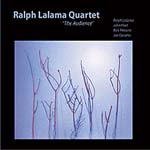 The
Audience The
Audience
Mighty
Quinn Productions
By Tom
Ineck
The
follow-up to 2008’s excellent “Energy Fields,” the latest release by the
largely unheralded tenor saxophonist Ralph Lalama is another
authoritative collection of tunes turned every which way but loose. It
is Lalama’s second CD on the Mighty Quinn label.
Boasting
the same rhythm section of its predecessor—guitarist John Hart, bassist
Rick Petrone and drummer Joe Corsello—“The Audience” continues the
quartet’s bluesy approach from the swaggering opener, Wayne Shorter’s
“Marie Antoinette,” with Lalama and Hart doubling the melody. Stevie
Wonder’s tale of urban strife, “Livin’ for the City,” gets an apt
soul-jazz treatment, and the sly “Love Thy Neighbor” features some very
hip, but subtle work from both Petrone and Hart.
In an
interesting exercise in contrasts, Lalama pairs off with each sideman
for a short improvised tune. He and Hart perform “Jonme,” which segues
neatly into the standard “Portrait of Jennie.” The duo of Corsello and
Lalama connect on “Jome” leading into the Latin bounce of “Kiss and
Run.” Predictably, Petrone joins Lalama for “Ricme,” with Lalama laying
out a bare-bones flurry of notes around which the bassist weaves his
lines.
Another
rarity, Duke Pearson’s “Minor League,” gets a swinging workout that
shows off Lalama’s huge tone and effortless improvisation as he
navigates through the changes. Hart and Petrone follow with equal aplomb
before the whole outfit goes through a bracing round of four-bar breaks.
Lalama nods
to mentor Sonny Rollins on a breezy rendition of Johnny Mercer’s “I’m an
Old Cowhand,” done in classic fashion by Rollins on his 1957 release,
“Way Out West.” In his playing, Lalama is more relaxed but similarly
adventurous in his snaking lines and sudden surges in tempo.
After too
many years in the shadows, the 59-year-old Lalama may finally be
stepping into the limelight. Let’s hope he continues his fruitful
collaboration with the folks at Mighty Quinn Productions.
top |
|
|
|
THE JEFF HAMILTON TRIO
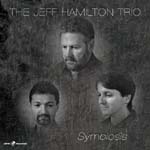 Symbiosis Symbiosis
Capri
Records
By Tom
Ineck
No matter
how good he is, a drummer usually is relegated to obscurity at the back
of the stage, hidden behind the cymbals and faithfully keeping time for
a spotlighted singer or a blaring horn section.
Jeff
Hamilton has done it all—literally taking a back seat to everyone from
Monty Alexander, Ray Brown, Gene Harris and Oscar Peterson to Ella
Fitzgerald, Rosemary Clooney, Ernestine Anderson and Diana Krall. In the
last 15 years or so, he also has found time to create some beautiful
recordings of his own. “Symbiosis” continues that trend.
Most
recently, Hamilton has developed an incredible rapport with the
wonderful bassist Christoph Luty and pianist Tamir Hendelman, a keyboard
genius of under-recognized brilliance. Over a period of six or seven
years, the three have achieved a level of interaction and virtuosity not
heard since the days of the Harris/Brown/Hamilton triumvirate.
“You Make
Me Feel So Young” is a superb example, with Hamilton conducting a
workshop on brush technique, alternately slowing down and accelerating
for dramatic effect, with Luty and Hendelman in lockstep. Throughout the
swinging opener, Hendelman ranges like a giant over the entire keyboard.
A haunting “Midnight Sun” has Hamilton employing his bare hands on the
snare, exchanging phrases with Luty’s lithe deep-throated bass and
Hendelman’s delicate piano filigrees.
For an
extraordinarily beautiful piano trio ballad, look no further than the
title track. “Symbiosis” is a typically romantic composition by Claus
Ogerman on which Luty shows his expertise with a bow as Hendelman
caresses the lovely melody and Hamilton tastefully seasons the
performance with his consummate brushwork. Piano and bass state get
funky with the familiar theme of “Fascinating Rhythm” while Hamilton
alternates between brushes and sticks for a tour de force drumming
demonstration.
Ray Brown’s
“Blues for Junior” pays homage to the late bassist with a typically
soulful, swinging foray into the blues. Hendelman is especially
impressive as he digs deeply into a relaxed, hesitation-style delivery.
Luty opens “Polka Dots and Moonbeams” with a lovely arco solo before
Hendelman states the melody and Hamilton creates a warm Latin groove,
again on brushes. Remaining south of the border, the trio perform
Hamilton’s snappy “Samba De Martelo.”
As arranged
by Luty, “Blues in the Night” is taken at a very slow tempo, giving
Hamilton and company plenty of opportunities for dramatic interaction.
Luty takes another stunning bowed solo. Hamilton finally pulls out the
stops on Miles Davis’ “Serpent’s Tooth,” driving the trio with
authority, changing gears and tempos at will and making the sticks
fairly crackle with electricity.
top |
|
|
|
ANGELA HAGENBACH
 The
Way They Make Me Feel The
Way They Make Me Feel
Resonance Records
By Tom
Ineck
A lot of
thought and talent went into the making of “The Way They Make Me Feel,”
and it has begun to pay off in increased nationwide recognition for
Kansas City-based singer Angela Hagenbach. The CD has been hovering near
the top of the jazz charts for weeks and is getting well-deserved radio
airplay.
It’s about
time. Hagenbach has enjoyed an area following for more than a decade,
but has had difficulty breaking through to a wider audience. With its
superb production values, top-notch musicianship and obvious thematic
approach “The Way They Make Me Feel” should change that.
From their
position as lesser-known composers of the Great American Songbook,
Johnny Mandel, Michel Legrand and Henry Mancini have received somewhat
grudging respect from jazz musicians and singers. As such, they are
perfect subjects for a tribute, and Hagenbach and company have done them
proud. We get four tunes by Mandel, four by Legrand and three by
Mancini, and the instrumentation alternates between small jazz
combo—with arrangements by pianist Hendelman—and expanded treatment with
strings, arranged by Kuno Schmid.
Mandel’s
“Cinnamon and Clove” gets things off to a rousing start with an
arrangement by Hendelman and incendiary playing by trumpeter Willie
Murillo and saxophonist Steve Wilkerson. Mancini’s “Slow Hot Wind” is a
perfect vehicle for strings, creating a warm backdrop for Hagenbach’s
equally sultry vocals. The two combine again for “Summer Me, Winter Me,”
a gorgeous ballad from the Legrand songbook that also features an
incisive guitar solo by Larry Koonse.
The
accordion of Frank Marocco opens an unconventional rendition of
Legrand’s “I Will Wait for You,” one of the most familiar tunes in the
set. It is taken uptempo and is handled in swinging, scatting fashion by
the husky-voiced Hagenbach, with Murillo and Wilkerson adding brassy
accents. Mandel’s “Quietly There” is given the full, lush string
treatment, while his “Sure as You’re Born” is taken at a brisk pace set
by bassist Kevin Axt and drummer Bill Wysaske and urged on by Koonse’s
scurrying guitar.
Hendelman’s
arrangement of Mandel’s “Close Enough for Love” evokes the French
impressionism of Debussy and Ravel as it teams Marocco’s accordion and
Wilkerson’s clarinet. Hagenbach opens “Charade” with some bluesy
scatting and gradually unwinds the lyric with typically sensuous
sonorities. The performance also is an excellent showcase for
Hendelman’s world-class playing.
The first
half of Schmid’s arrangement of Mancini’s “Whistling Away the Dark”
marries Hagenbach’s breathy voice with strings, and the jazz rhythm
section enters only after the proper mood has been established. The
ambiance of the French cabaret returns with clarinet and accordion for
Legrand’s intimate “His Eyes, Her Eyes.” Schmid’s stirring arrangement
for Legrand’s “The Way He Makes Me Feel” creates a fitting close to this
loving collection of love songs.
top |
|
|
|
THE MICROSCOPIC SEPTET
 Lobster
Leaps In Lobster
Leaps In
Cuneiform Records
By Tom
Ineck
On the
strength of four LPs released in the 1980s, The Microscopic Septet drew
a small—but extremely astute and adventurous—cult of fans. Those of us
who consider ourselves among that number rejoice in the return of the
Micros with “Lobster Leaps In.”
Pianist
Joel Forrester and soprano saxophonist Phillip Johnston remain the
creative geniuses behind the music, each composing five of the numbers
included here. Every tune takes full advantage of the unusual
format—four saxophones, piano, bass/tuba and drums. In addition to
Forrester and Johnston, the current lineup includes Don Davis, alto sax;
Mike Hashim, tenor sax; Dave Sewelson, baritone sax; David Hofstra,
bass; and Richard Dworkin, drums.
As some
discerning critic once wrote, the Micros music combines elements of Duke
Ellington, Charles Mingus and Spike Jones. The result is a wacky blend
of catchy melodies, complex brass harmonies and accessible rhythms that
simply defy convention.
Former
Micro Wayne Horvitz composed the opener, “Night Train Express,” which
aptly begins with the warning, “All aboard! Next stop, oblivion!” It has
the horns alternately pumping in unison and snaking off in solo
excursions. As the title implies, “Disconcerto for Donnie” is a bright
and bouncy Latin number that eventually takes on some very disquieting
characteristics. With the title track, the Micros continue their
obsession with the clawed crustacean (“The Lobster Parade” and “Lobster
in the Limelight”) and—perhaps—parody the swing classic “Lester Leaps
In.”
Offbeat
tango rhythms infuse “Got Lucky” with a frantic mood that does, indeed,
evoke the inspired lunacy of Spike Jones. “Lies” begins like a funeral
dirge but eventually blossoms into an interesting bop tune first stated
by Forrester on the piano. A mighty funk esthetic drives the bluesy
“Life’s Other Mystery,” which gets a boost from Sewelson on baritone,
Hashim on tenor and Dworkin’s powerhouse drumming.
Everyone
sounds slightly askew on “Almost Right,” an exercise in discordant
accord by Johnston, who acknowledges that the notion of error is a
recurring theme of his. Sewelson and Hofstra are featured on “Money,
Money, Money.” After the duo’s free-blowing intro, the band settles down
to a soulful R&B groove. “Lt. Cassawary” is an infectious romp with
insurgent horns seemingly breaking out of the section at will.
Unusual
changes of chord and meter are the name of the game on “Twilight Time
Zone.” The whole affair comes to a close with “The Big Squeeze,” a
loping, atmospheric tune that gradually develops from a film noir stroll
to a back-alley cat fight and finally into a raucous, brawling mix of
horns and percussion.
There is
more good news for fans of the Micros. Two double-disc anthologies of
the band’s music were released in 2006 under the titles “Seven Men in
Neckties: History of the Micros, Vol. 1” and “Surrealistic Swing:
History of the Micros, Vol. 2.” Together, they comprise everything they
recorded in the 1980s, including bonus tracks. Also available on the
Cuneiform label, they have lost none of their twisted charm over the
years.
top |
|
|
|
JACKIE RYAN
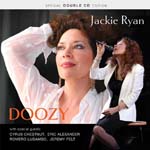 Doozy Doozy
OpenArt
Productions
By Tom
Ineck
Every now
and then, one slips through the cracks. Such is the case with marvelous
singer Jackie Ryan. Recording on minor, independent labels since at
least 2000, she has managed to fly well under our radar. Gotta get that
radar fixed one of these days!
Our former
ignorance of Ryan makes her sixth and latest release, the double-disc “Doozy,”
a particularly pleasant surprise. It contains 20 excellent performances
spanning ballads, uptempo swingers, Latin numbers, standards and obscure
tunes alike, and totaling about 100 minutes. It features top-flight
accompaniment from pianist Cyrus Chestnut, saxophonist Eric Alexander,
trumpeter Jeremy Pelt, guitarist Romero Lubambo, bassists Ray Drummond
and Dezron Douglas and drummers Carl Allen and Neal Smith. To put things
in perspective, it also has insightful liner notes by the esteemed Don
Heckman.
The
enormous breadth of this recording makes detailed commentary impossible
here. Suffice it to say that it surprises and delights at every turn.
The title track is a Benny Carter gem that swings with clever vocalese
lyrics penned by Ryan and great playing by Chestnut, Alexander and Pelt.
A wonderfully tasteful and accomplished keyboard wizard, Chestnut is
justifiably featured throughout this project, and his playing is a
perfect foil for Ryan’s vocal excursions.
We
luxuriate in the lush warmth of “You’ll See,” and the sunny Jobim
standard “Caminhos Cruzados.” We smile knowingly at the scolding bopper
“Do Something” and turn sentimental at the wistful “With the Wind and
Rain in Your Hair.” Pelt’s brilliant flugelhorn, a light samba feel and
Ryan’s crystal clarity bring new meaning to “Speak Low.”
You believe
Ryan when she first whispers, then swaggers on “I Must Have That Man,”
and she makes the bluesy “Dat Dere” both whimsical and convincingly
instructive. Chestnut digs imaginatively into the rumba sway of
“Beautiful Moons Ago,” a rarity by Nat Cole and Oscar Moore. Set one
ends with the rockin’ blues shuffle of “My How the Time Goes By,” which
illustrates Chestnut’s penchant for blues and gospel music.
Songwriter
Oscar Brown Jr. gets his due with the clever second-half opener
“Opportunity Please Knock.” Alexander is the featured soloist on that
tune and the next, the ballad “I Haven’t Got Anything Better To Do,” an
obscure but lovely song from the 1967 Sandra Dee movie “Doctor, You’ve
Got to be Kidding!” Lubambo returns on guitar for the
breezy bossa medley “Brigas Nunca Mais/A Felicidade.”
Among the
handful of well-known standards included here is a tender, definitive
reading of “Spring Can Really Hang You Up the Most.” The Mexican love
song “Solamente Una Vez” is a duo showpiece for Ryan and Lubambo and
provides a nice segue to the bossa nova arrangement of “Summer
Serenade,” another Benny Carter gem. “Get Rid of Monday” is a
lesser-known, witty swinger from Johnny Burke and Jimmy Van Heusen, with
soulful statements by Chestnut and bassist Dezron Douglas.
Alexander’s
sensuous horn imbues the slow, evocative “Midnight Sun” with the proper
romantic ambiance for Ryan’s virtuosic vocal excursions. The bold and
brassy song stylist swaggers in the tradition of “St. James Infirmary”
on Billie Holiday’s “Tell Me More and More and Then Some,” given a
distinctive New Orleans flavor by Pelt’s plunger-muted trumpet solo.
Leonard Bernstein’s timeless “Some Other Time,” with exquisite piano
filigrees, makes a fitting close to this extraordinarily rich and
satisfying “Doozy.”
top |
|
|
|
THE ERIC MUHLER QUARTET
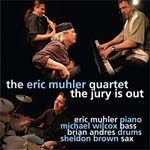 The
Jury Is Out The
Jury Is Out
Slow
Turn Records
By Tom
Ineck
“The Jury
Is Out,” his fifth recorded outing, captures pianist Eric Muhler with
his tight quartet in a live setting at The Hillside Club, an intimate
150-seat venue in Berkeley, Calif. The tunes are challenging originals,
the interplay is telepathic and the engineering is superb.
While
Muhler’s solo piano style tends toward Keith Jarrett and Art Lande, his
approach in this fearsome foursome sounds more like the hard-charging
post-bop of McCoy Tyner or Art Blakey’s Jazz Messengers, especially when
fired by the brawny tenor sax of Sheldon Brown, the booming electric
bass of Michael Wilcox and the prodigious time-keeping of drummer Brian
Andres.
“Punkly”
opens the proceedings with an unusual 12-bar blues pattern. “Sand
Castles” is a blatantly Tyneresque exploration of modes and wide-ranging
keyboard excursions. Brown switches to soprano sax to state the
melodious theme of “Alexandra Cristina A.M” before turning it over to
Muhler, who brilliantly expands on the theme with a piano solo
alternating deft single-note runs with lush arpeggios.
The title
track is a complex, stop-time composition which shifts gears at a
moment’s notice. All four players hold tight to the reins, even while
galloping at breakneck speed. Brown turns in another exemplary tenor
solo, followed by an equally inspired piano statement. As its title
implies, “Sun & Clouds” allows many glimpses of sunny optimism between
the darker chords. Indeed, Brown’s soprano sax positively beams,
Wilcox’s bass solo soars in the virtuosic style of Stanley Clarke and
Muhler expresses some Chick Corea inclinations as the tune stretches to
almost 13 minutes.
Two
compositions devoted to “Jane” close the CD, “1990 For Jane” and “Jane
at Home.” The former is a Latin tune taken at a stately mid-tempo, with
a melody first introduced by Wilcox on bass, then expanded on by Muhler
and Brown on tenor. The latter slows the pace slightly as Brown’s tenor
states the funky, catchy theme with gusto. The whole quartet reconvenes
for a gospel-like testimonial, Muhler pounding out the chords and Brown
wailing on the horn.
Late
breaking news! The jury is in and the verdict is that The Eric Muhler
Quartet has a winner on its hands.
top |
|
|
|
By Tom
Ineck
Guitarist
Royce Campbell is so prolific that his two latest projects were recorded
just six weeks apart, in December 2008 and January 2009. Both feature
Campbell’s current sidemen—bassist Bob Bowen and drummer Ron Free—in
thematic programs directly alluded to in their titles.
“All
Standards… and a Blues” and “Movie Songs Project” extend Campbell’s
catalog to more than two dozen recordings in the last 20 years. Previous
gems include a 1995 tribute to the music of Henry Mancini, a 1999
session with strings and Fred Hersch at the piano, and “Six By Six: A
Jazz Guitar Celebration,” pairing Campbell with fret-masters John
Abercrombie, Larry Coryell, Pat Martino, Bucky Pizzarelli and Dave
Stryker.
ROYCE
CAMPBELL TRIO
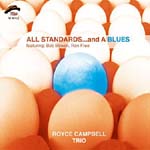 All
Standards… and a Blues All
Standards… and a Blues
Philology Jazz
“All
Standards” pares nine familiar tunes to their essence as Campbell states
the melodies on guitar, Bowen anchors the low end of the scale while
suggesting harmonies and pulse, and Free establishes the tempo and
strings ornate percussive arabesques throughout. This trio is the very
definition of teamwork.
In the
absence of a piano, Campbell’s string excursions ring crystal clear,
effortlessly alternating between lush chords and single-note runs,
especially given the subtle, unobtrusive accompaniment of bass and drums
on ballads like “’Round Midnight,” “I Thought About You,” “The Boy/Girl
Next Door,” and “Darn That Dream.”
But the
trio chemistry is most evident as the three wend their way through more
complex melodies and time signatures, such as “Out of Nowhere,” “Love
For Sale,” “Have You Met Miss Jones?” the jazz waltz “All the Things You
Are” and “You’d Be So Nice to Come Home To.” Coming as it does halfway
through the set, Campbell’s original “Trio Minor Blues” is a refreshing
palate cleanser between two hearty helpings of chestnuts.
ROYCE
CAMPBELL TRIO plus PHIL WOODS
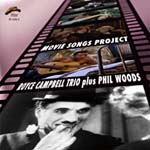 Movie
Songs Project Movie
Songs Project
Philology Jazz
“Movie
Songs” adds alto saxophone legend Phil Woods to the trio in a collection
of film theme ranging from the obvious jazz standards—“You Must Believe
in Spring,” “The Shadow of Your Smile,” “Laura,” and “Secret Love”—to
the less obvious “Theme from Amarcord,” and Mancini’s “Baby Elephant
Walk” and “Soldier in the Rain.”
Woods, age
77 at the time of this recording, still exhibits the sure-fingered
dexterity and well-developed sense of swing that make his sound so
instantly recognizable. He heightens the excitement level every time he
blows a figure on his horn. Campbell and company lend faithful
accompaniment to the master, but also offer their own imaginative solo
statements. Among the highlights are the waltz masterpiece “Amarcord,”
the gentle samba “Manha de Carnaval” and Campbell’s Wes
Montgomery-style, octave flights on the trio rendition of “Laura.”
On an
updated reading of Charlie Chaplin’s “Smile,” Woods whimsically quotes
from “When You’re Smiling (The Whole World Smiles with You).” A bluesy
R&B swagger pervades “Baby Elephant Walk.” Campbell’s guitar artistry is
most evident as Woods sits out the closer, the heart-rending “Soldier in
the Rain.”
top |
|
|
|